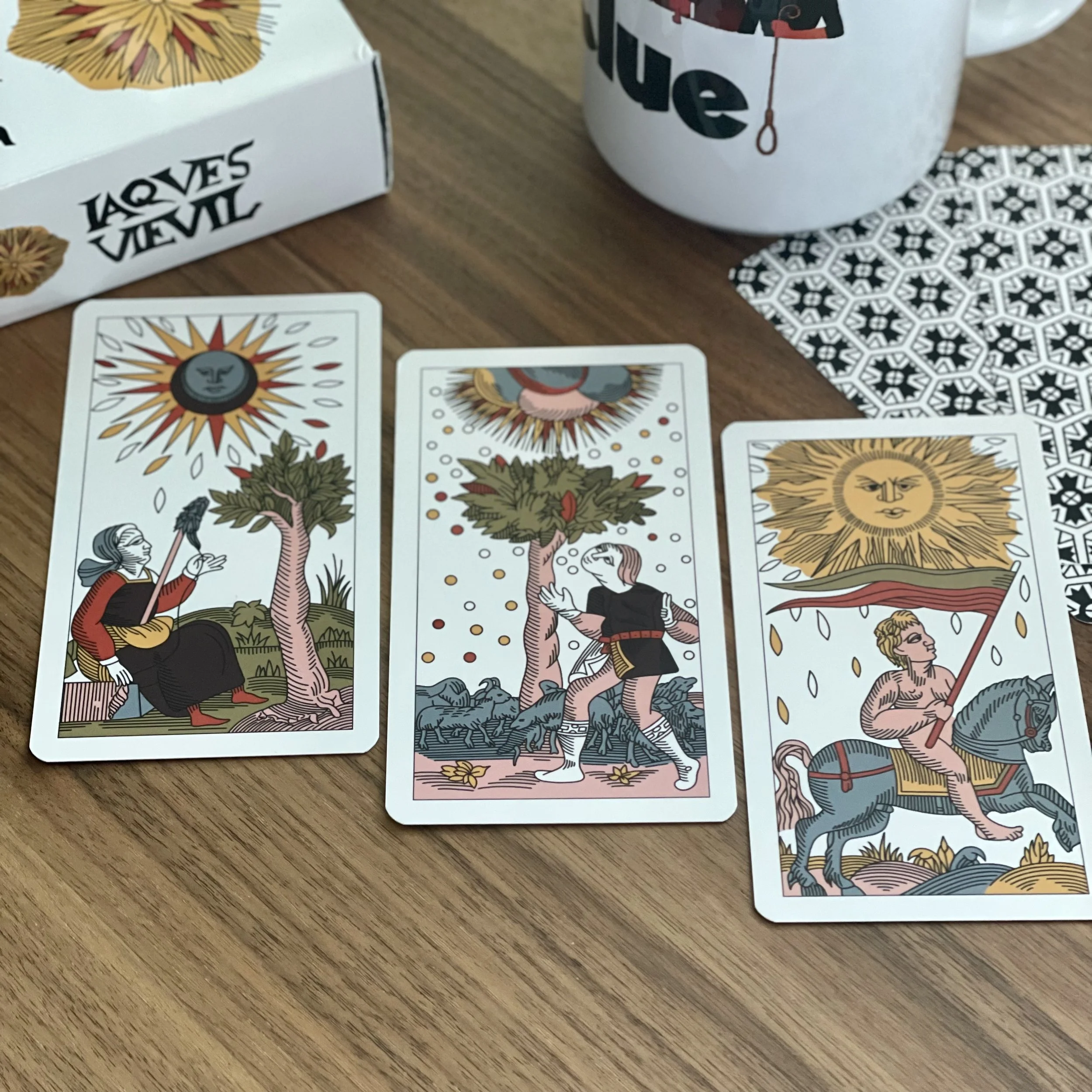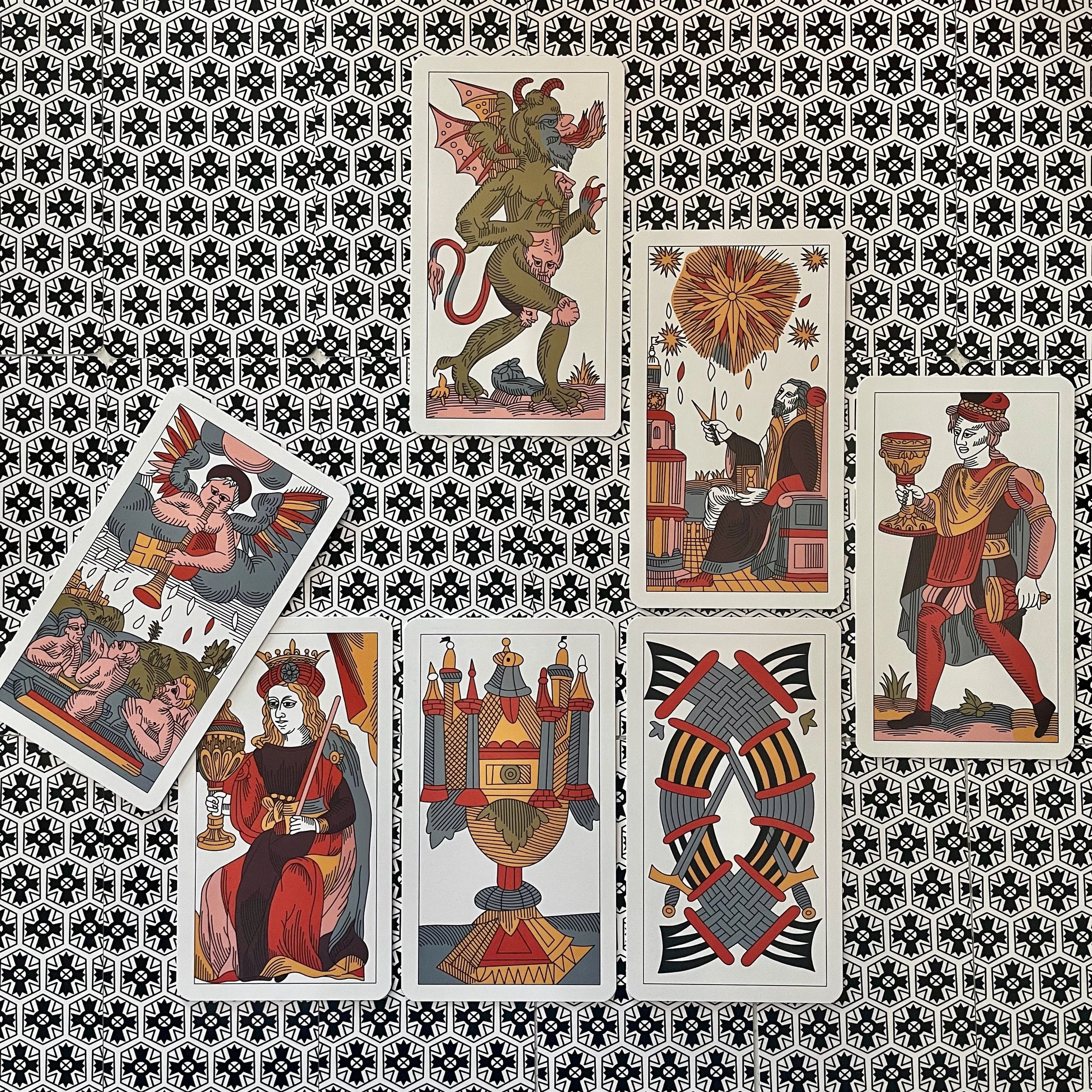Deck Interview: Jaques Vievil Tarot
I don’t remember how I became familiar with the Jaques Vievil Tarot, but after expressing my enjoyment for the surprisingly … grumpy faces on some of the cards, the deck’s creator (Gergely Bagaméri of Midnight Tarot) gifted me a copy of this familiar yet strange version of the tarot.
In many ways, the original Vieville Tarot is very similar to the cards of the Tarot de Marseille tradition. For example, the minor arcana are pips based on simple patterns, and the Lovers shows three humans plus Cupid to signal the choice of loving, not just the romance. I plan to read almost all the cards in a similar way as I would the Marseille.
But in other ways, the deck (or this modern remake of it) are different. For one, five of the “cosmic” major arcana show different imagery. Two of them appear in my interview spread, and I’ve included the other three in an image here. Deck creator Bagaméri includes Marseille-like variants of these five for those who want the more familiar majors. Personally, I love these “new” (to me) variants designed by Vieville, and I plan to use them.
The other most notable difference is the dour faces on the court cards. They’re so grumpy. Gergely Bagaméri definitely advocates for leaning into the unusual humor they can provide, and that’s something I found in my initial reaction to the cards—especially the Devil—and reiterated in my deck interview.
It’s been a while since I’ve done one of these, so if you need a refresher on the card layout, you can find my original deck interview spread here on my blog.
These are the Moon, Tower, and Sun cards from the Jaques Vievil Tarot. The weaver by the tree for the Moon gives me the feeling of a Norn, but it’s hard for me to guess how relevant that would have been beyond the völva having Moon-like mystical powers. I’m guessing that the Tower depicts Adam in the Garden of Eden because what else makes a guy by a tree (without lightning a Tower moment? The Sun card includes the solitary naked rider and red flag of Pamela Colman Smith’s famous naked-baby version. The Clue mug is just for fun because it’s an amazing movie.
For this interview, I thought it would be fun to walk through my process as well as the actual interview interpretation. For those learning tarot or learning to use new decks, it can be helpful to see how the sausage is made. I should note that most of this “process” occurs in a matter of seconds, but I’m self-aware enough (thanks, metacognitive exercises) to be able to distill the highlights.
I went into this interview after first creating a meme of the Fool and the Devil for Instagram. I’m not a meme person. I think a lot of the blame for social disconnection (among friends and acquaintances) on the internet and the proliferation of copying others’ content can be traced back to the dominance of meme culture. Memes have been around for thousands of years (it’s an ancient Greek word and concept), but they function differently online.
Don’t get me wrong: I think a lot are funny, even when I’ve seen them before, and they offer a shorthand to social connection and bonding over shared interests and inside jokes. But in the current social media climate, where the algorithms love easy consumption and reward a quick laugh, they flood our feeds and often replace deeper connection and individual creative expression.
Consider the talented artist and deck creator James Brothwell (@PixelOccult). I see almost every one of his meme posts on Instagram, but I almost never see his evocative art because that content isn’t pushed to my feed, even though I intentionally swipe past many memes and actively seek out his art posts. The memes just get too much traction with a wider audience and drown out my personal preferences of his posts.
My own astrology fun charts have made their way around astrology groups on Facebook (of which I’m not a part) a few times and in stories on Instagram, far more than other more meaningful content (even more than my most popular divination challenges). And that traction with an AI is why I made them. (That and the proliferation of similar charts at that time were based on simplistic views of astrology and minimal creativity, so I figured, what the hell do I have to lose?)
I know I sound like a grumpy court card, but I promise I’m not, and this deck interview reminded me of that. The point of this very long tangent is that I was immediately drawn to the fun nature of the Devil card in this deck. I could hear them sniggering as they creeped up on the unexpected Fool, who is in a similar posture. Does the Fool become the Devil (as the Fool becomes Death in the Marseille)? It made me think of the “me coming back with my bullshit meme,” so I made it into that.
This initial humorous read of the Devil and how I wanted to feature this deck in ways that were somewhat unconventional were an a priori for my use and interview. So it’s no surprise the Devil and that playful attitude come into this reading.
Deck Interview with the Jaques Vievil Tarot
What major lesson are you here to help me learn? Ace of Cups
Through which divine energy can we best communicate? The Devil
In what area can you aid me to help others? 10 of Swords
In what area could your guidance be easily misunderstood? Queen of Cups
What can I do to keep our communication clear? Judgment
How can I use your guidance for the highest good? The Star
How will I know when we’re ready for a new lesson? Valet of Cups
For the first card, I pulled the Ace of Cups and thought of emotional intensity (not love). The next was the Devil and their silly sneakiness, their (and thus my) socially determined “bullshit.”
The emotional intensity of the Ace of Cups in the context of my “priors” and the Devil becomes a lesson in emotional honesty. The lesson the deck provides is about connecting honestly to the humor and emotional reactions I experience in response to these cards. With the Devil as the divine entity through which I can connect to this deck, I had to lean into the trickster vibe of it. I’m certainly not literally working with the Devil, but I recently listened to a podcast interview with Ian Chambers, who explained that, as a traditional English witch, he does worship the Devil in the sense of a trickster god who will absolutely ruin your life if you’re not careful how you play together. So I interpret this as a call to embrace the trickster energy that this deck first elicited from me. Embrace the fun and the silly along with the rest.
Then for position three came the 10 of Swords—this deck doesn’t include numbers or titles, so you have to count the pips and know the figures—which looked like a muddled mess to me. You might interpret it as the culmination of some communication or mental efforts or too many competing interests. For me, I saw an interwoven tangle. One of the oddities of this deck (and I’m not sure if it’s Vieville’s or Bagaméri’s artistic choices) is that there is a lot of color bleed and incomplete shapes. That came through along with the intertwining of the eight swords and the fighting of the two.
Moving to the fourth card, I pulled a Queen. I assumed it was the Queen of Cups because of the giant cup, but then noticed a staff as well. The royals have royal scepters. That’s a thing, so I went back to my initial read of the Queen as the Queen of Cups. But the combination of opposing suits (fiery Batons and watery Cups) added a layer of confusion and uncertainty in self. Paired with the middle of the 10s and the need for emotional honesty, I was thinking that this Queen represented someone who was confused about who they thought they were supposed to be. It wasn’t about what they wanted for themself but what was expected.
And with Judgment as the card to bring clarity, it seemed an appropriate embracing of the fire and water elements of the Cups with a Baton. That’s because Judgment can be read as a fire card and, less often, as a water card. (There’s so much water in the Pamela Colman Smith illustration after all. And some people see the horn-blowing angel as Gabriel, angel of the water quadrant in Victorian esotericism.) Clarity in purpose and focus on the big picture really seemed important here as a major arcanum that shows someone blasting noise to shake things up in contrast to some minor arcana.
Together, these three cards suggest the deck helping when someone is stuck in a muddled mindset and is overly sensitive to others’ opinions and abstractions. The Queen of Cups in my elemental patterning is very liquid (water rank + water suit), and she seems very forlorn, despite having the Cup in her hand. Snap out of it, sourpuss! Honor your feelings and emotional honesty, but that’s not the same as losing yourself in the empath’s muddle of others’ thoughts and feelings. And with the Devil presiding, it also feels like a call to get one’s head out of la la land and focus on reality. That’s not the same as materialism since Judgment still feels spiritual, but more tied to the reality of feeling and how certain choices or unnecessary burdens have downstream effects on your lived reality.
The sixth card offers a reminder of the big picture for me as I help the querent focus on their own big picture, and that’s the Star. This is another of the five majors that departs from the Marseille, and it’s one of the two more significant changes (along with the Moon). I wasn’t really sure what to make of it here at first. I certainly wasn’t thinking of hope but more world-weariness. The astronomer just looks so exhausted and not at all excited for the falling rays of starlight. It’s as if they’re wondering what on earth is happening up there.
But as I sit here looking at the details in the context of this reading, it’s a reminder that the higher purpose is that there IS a higher purpose. The astronomer is exhausted by everything, and all the little pieces of light falling from the giant Star may seem like something to focus on, but they’re unimportant to the big picture. In this whole spread, the major arcana are really helping to clarify and keep things honest to one’s true, lived reality. It doesn’t have to get overly abstract and esoteric and high vibe to be meaningful and true and major.
I almost didn’t pull the last card since I rarely do second deck interviews these days. (I haven’t even done first interviews for the majority of my decks at this point! They just keep piling up.) But on a whim, I thought it might be useful (beyond just finishing out the spread for this post), and it was. It was a very grumpy Valet (Page) of Cups, which reminds me that this deck is fun for me, as well as emotionally honest. And when I lose that sense of fun with it or it becomes an outright downer, it’s time for a refresh and a new lesson. I’m not a good-vibes only person, but I don’t think suffering is inherently virtuous, and I certainly don’t want to slip into a state where the readings are always bummers.
You can purchase the Jaques Vievil Tarot (and other decks) through the Midnight Tarot Etsy shop.



